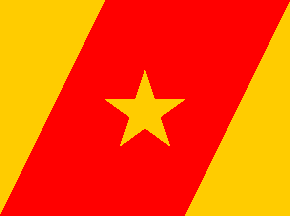
Last modified: 2011-09-09 by bruce berry
Keywords: amhara | ethiopia |
Links: FOTW homepage |
search |
disclaimer and copyright |
write us |
mirrors
 Image by Jaume
Ollé, 18 Dec 1999
Image by Jaume
Ollé, 18 Dec 1999
See also:
Amhara, according to the Ethiopian Parliament
website
"consists of 10 administrative zones, one special zone, 105 woredas, and 78 urban centers. The capital city of the State of Amhara is Bahir-Dar and
the State of Amhara is located in the north western and north central part of Ethiopia.
The State shares common borders with the state of Tigray in the north,
Afar in the east, Oromiya in the south,
Benishangul/Gumuz in the south west,
and the Republic of Sudan in the west. Finally, the State of Amhara
covers an estimated area of 170,752 square kilometers.
This is an ethnic state with 91.2% of the population (of 13,834,297)
belonging to people of Amhara ethnicity.
Ethiopia changed it's internal administrative divisions when it
changed regime and flag in 1996. Previously, the city of Bahir-Dar made
the border between the former provinces of Gojam to the south and Gonder to the
north. It also means that the change was not simply a rearrangement of the
internal borders, but whole new borders where created because Gonder
bordered Eritrea and Amhara does not.
Jorge Candeias, 15 Dec1999
The flag of Amhara is golden with a broad red diagonal across the center, charged
with a golden star in the center. There's no information on the symbolism, but it's interesting to note that the neighbouring state of
Tigray has the same colours.
Jorge Candeias, 15 Dec 1999
The traditional colours of Amhara are yellow and red. The colours probably
originate from
medieval Catalan and are widely used, including for the main Amharic football team.
The Tigray colours are derived from the flag of the main revolutionary party and
symbolise socialism and progress - same colours but different meaning.
The flag image as published in Flagmaster nr. 93 (Spring 1999)
[fLm] is incorrect in the size of the diagonal stripe.
Jaume Ollé, 18 Dec 19999